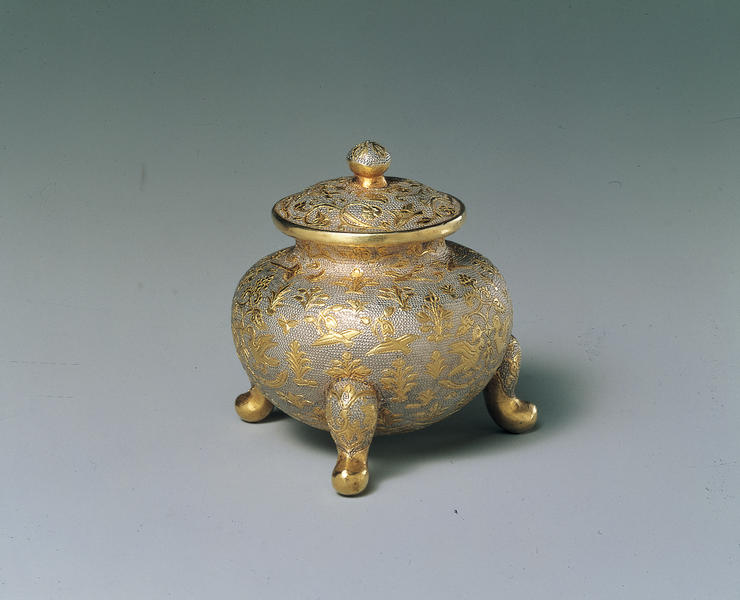花鳥文蓋付三足容器
- 中国
- 中国・唐時代
- 7世紀後期-8世紀
- 銀鍍金
- H-5.2 D-5
この小さな容器の器体は初めに銀の円盤から鍛造で成形され,外に反った縁をもつ球形をなしている。次いでこれより小さな銀の円盤から,鍛造で中央が膨らんだ蓋を成形する。蓋のつまみと3本の脚はあらかじめ鋳造され,本体に溶接されている。さらに容器の本体および蓋の外側の表面を,飾り付けに備えて鍛造で滑らかに仕上げている。器の本体の中央の部分には縁起のよい植物をくわえた一番の燕,さらにそれぞれ2羽の鴛鴦とオウムが,生命の樹の文様とこれより小さな植物モティーフがちりばめられた中に配されている。蓋も同様に鳥と植物の文様が配されており,器体の底には中心に曲線形のロゼット文がある。
Catalogue Entry
Bronze tripod vessels were originally used for rituals during the Shang ( 1500-1028 B.C.) and early Western Zhou (1027-771 B.C.) dynasties. By the Spring and Autumn period (771-476) such vessels, at times featuring lids, had become more utilitarian. During the Warring States period (475-221 B.C.), some tripods began to feature purely decorative patterns, and by the Han dynasty (206 B.C.-A.D. 220), tripod lacquerware was popular as well. However, it was not until the Tang dynasty (A.D. 618-907) that miniature tripods, fashioned out of precious gold and silver, were created solely as decorative objects of art.
The body of the small Shumei tripod was initially fashioned out of a disc of silver that was hammered into a globe form with a flared lip.1 A smaller circular silver disc was then hammered into a convex lid. The lid finial and the three tripod legs were cast in silver before being soldered on. The exterior surfaces of the vessel and lid were then hammered to a smooth finish to prepare them for decoration. The central section of the tripod body features a pair of swallows holding auspicious plants, as well as two mandarin ducks and twin parrots, among tree of life designs and scattered smaller floral motifs. The lid, too, has bird and floral designs, and the entire base of the tripod body is patterned with a central, curvilinear rosette motif.2 A metalsmith painstakingly traced all motifs onto the tripod and lid surface with a series of single chisel punches (as opposed to using a chasing technique which would have resulted in motifs with continuous fluid lines). The tripod's pictorial composition is complemented by a low, ring-matted background. The bird, flower, and rosette motifs on the body are gilded, as are the lower portions of each leg, the rim of the lid, and the lower portion of the lid's final.
The pair of swallows holding floral twigs in their beaks is a variation of a popular Persian and Sogdian motif. Symbolizing imperial power, success, and good fortune, this Near Eastern motif, often placed within a roundel with a pearl border, was commonly used to pattern polychrome silk collars and sleeve trim as well as the bodice sections of garments.3 Referred to in Tang-period texts as "swallow with ribbons in its bill" or "pheasant with auspicious plants in its bill," this motif appears in China on textiles from the fifth to the eighth centuries and, by the Tang period, was being patterned onto silver as well.4
A tripod similar to the Shumei example was unearthed from a suburb of Xi'an; another tripod with Confucian scenes was excavated from Beiyin village.5
JMS
1. Technical information courtesy of Pieter Meyers and Richard H. Kimball
2. On the evolution of the rosette motif in Chinese textiles see Segraves 1996a, pp. 54-62. For about the tree of life motif see cat. no. 133, n.5.
3. Zhong guo Zangxui 1996.1, pp. 3-26; O'Neill 1982, p. 168, pl. 107.
4. The well-known archaeologist Xia Nai coined the expression "standing bird" or linao to describe this motif. In some Near Eastern versions the bird appears to be holding a necklace. Based on excavated textiles and wall paintings, this motif can be dated to the fifth-eighth centuries A.D. in Kucha and Baicheng in Xinjiang and Bamiyan in Afghanistan. Textiles with this motif that date from the seventh to the eighth centuries have also been found in Tibetan graves in Dulan Xian in Qinghai province. Initially, this bird motif symbolized royal power, but was later its incorporated into Buddhism and came to represent rebirth. See Zhong guo Zangxui 1996.1, pp. 3-26.
5. Gong and Han 1993, pl. 89; Wenwu 1996.1, pl. 4.
